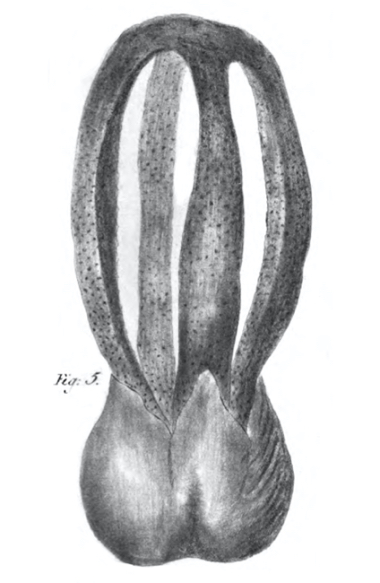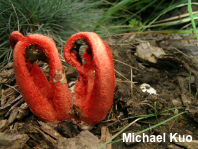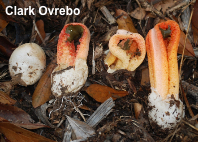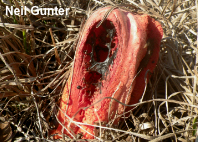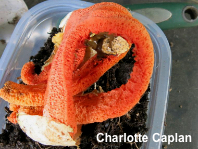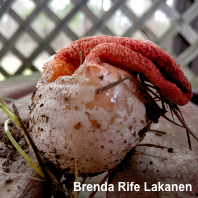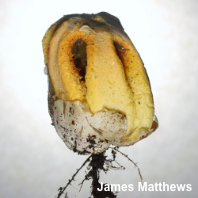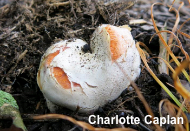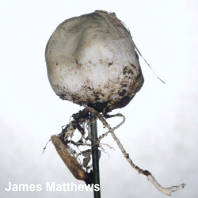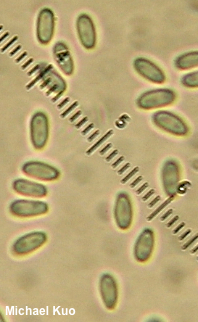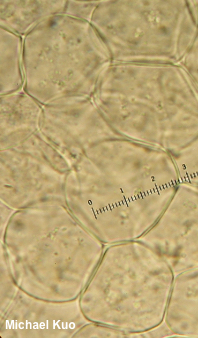| Major Groups > Stinkhorns > Clathrus columnatus |

|
Clathrus columnatus [ Basidiomycota > Agaricomycetes > Phallales > Clathraceae > Clathrus . . . ] by Michael Kuo Like other stinkhorns, Clathrus columnatus arises from a partially submerged "egg" that is attached to the ground with long cords. There is no stem; two to five hollow "arms" reach upwards, out of the egg, and join at the top—like columns that are prepared to hold something aloft. The inner surfaces of the arms are covered with stinkhorn slime, which has a foul odor and attracts flies; this is the mushroom's method for dispersing spores. Clathrus columnatus is fairly common along the Gulf Coast, where it often appears in urban settings (lawns, gardens, and so on). It is fond of woody debris, and frequently appears in woodchip mulch. It is not limited to the southeast, however; I have found it in central Illinois, and it has been reported as far north as Pennsylvania. Pseudocolus fusiformis has 3–4 arms that arise from a shared stem (which may be very short and hidden in the volva); the interior surfaces of its arms are covered with spore slime for at least the top half or two-thirds (sometimes all the way). Its eggs—and consequently its volva—are typically grayish to grayish brown (not white), and its range extends from Pennsylvania and New England to the Carolinas. The best way to determine whether or not your columnatus-like stinkhorn's arms share a stem (which would indicate Pseudocolus fusiformis, instead), is to tease the thing apart with a knifepoint or dissecting needle; the arms of Clathrus columnatus, once freed of the volva, are clearly separate, and not at all fused. Clathrus columnatus was first described from South Carolina by Bosc, in 1811. An English translation of the original description, along with the original illustration of the species, can be found below. Clathrus bicolumnatus, reported from California, is smaller (up to 9 cm tall) and has only two columns; it is yellowish to orangish. Linderia columnata and Laternea columnata are synonyms. Thanks to Charlotte Caplan, Neil Gunter, Brenda Rife Lakanen, and James Matthews for documenting, collecting, and preserving Clathrus columnatus for study; their collections are deposited in The Herbarium of Michael Kuo. Thanks to Clark Ovrebo and Cathie Aime for facilitating study of their collections. Description: Ecology: Saprobic; growing alone or gregariously; often near woody debris (sometimes directly from stumps or living trees) in lawns, gardens, cultivated soil, and so on; spring through fall, or over winter in warm climates; distributed in North America from roughly Pennsylvania to the Gulf Coast and Mexico; also found in the Caribbean, Central America, and South America. The illustrated and described collections are from Arkansas, Florida, Illinois, Louisiana, Texas, and Virginia. Immature Fruiting Body: Like a whitish "egg" 2–3 cm high; when sliced revealing the red to orange stinkhorn-to-be encased in a brownish gelatinous substance. Mature Fruiting Body: 5–12 cm high; 2–4 cm wide; consisting of 3–5 column-like arms arising separately (not from a shared stem structure) and joined seamlessly at the apex; arms arising from a white volva; base attached to white rhizomorphs. Arms: Up to about 1 cm thick; more or less equal; sometimes becoming flattened on the outer edge; hollow; spongy and soft; finely pocketed; orange to red, fading to pinkish or pinkish orange or nearly yellow. Volva: Sac-like, encasing the base of the fruiting body; white. Spore Slime: Brown; produced on the inner edges of the arms near or just below the apex of the stinkhorn; malodorous. Microscopic Features: Spores 3.5–4.5 x 1.5–2 µm; subellipsoid to cylindric; smooth; hyaline to faintly yellowish in KOH and Melzer's reagent; walls not cyanophilic; often with one small droplet near each end. Sphaerocysts of the branch context 16–56 µm across; subglobose to irregular; smooth; walls 0.5–1 µm thick; hyaline in KOH. Volval hyphae interwoven; occasionally branching; 2–8 µm wide; smooth; thin-walled; hyaline in KOH; clamp connections not found. REFERENCES: Bosc, 1811. (Saccardo, 1888; Coker & Couch, 1928; Dring, 1980; Smith, Smith & Weber, 1981; Weber & Smith, 1985; McKnight & McKnight, 1987; Lincoff, 1992; Metzler & Metzler, 1992; Calonge et al., 2005; Miller & Miller, 2006; Kuo & Methven, 2010; Elliott & Stephenson, 2018.) Herb. Kuo 09270601, 08291302, 02111501, 01081601; 02231701. Herb. CSU CLO-4992. Herb. PUL F3989. Clathrus columnatus Bosc, Magazin der Gesellschaft Naturforschenden Freunde Berlin 5: 85 (1811). English translation of protologue by Stephen Canfield COLUMNAR CLATHRUS. Clathrus columnatus Bosc. An oblong Clathrus with four distinct, quadrangular, vermillion colored arms. This species is most closely related to the grid Clathrus in terms of material characteristics and color but differs greatly in terms of its consistent shape and appearance as determined through examination of more than one hundred individual specimens. It grows in the sandiest areas of South Carolina from the beginning of February. Its odor is fetid. While the volva is not open, this species resembles a puffball (Lycoperdon). Plate 5. Fig. 5A is a full-size representation of the columnar Clathrus.
(Protologue illustration, public domain, adapted from a scan provided online by the Biodiversity Heritage Library (https://www.biodiversitylibrary.org/page/27273476#page/305/). This site contains no information about the edibility or toxicity of mushrooms. |
© MushroomExpert.Com |
|
Cite this page as: Kuo, M. (2020, July). Clathrus columnatus. Retrieved from the MushroomExpert.Com Web site: http://www.mushroomexpert.com/clathrus_columnatus.html |
